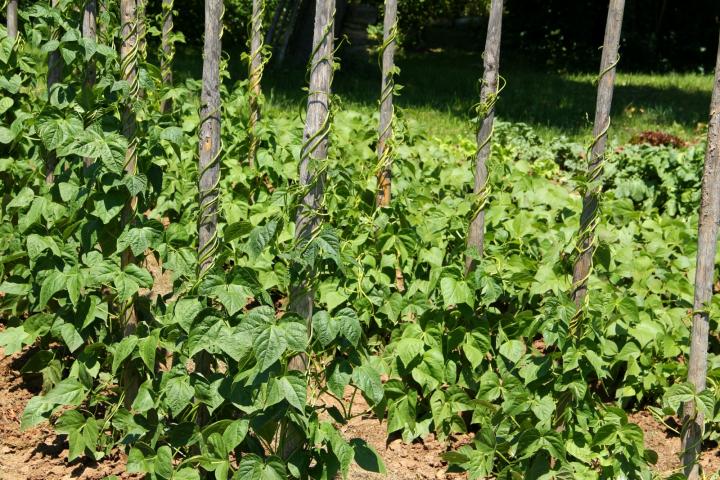| Anthracnose |
Fungus |
Yellow/brown/purple/black spots on leaves; sunken, dark spots on stems and pods; spots may develop a salmon-pink, gelatinous mass; eventually, rot |
Destroy infected plants; choose resistant varieties; provide good drainage; avoid overhead watering; apply compost; use mulch; rotate crops |
| Aphids |
Insect |
Misshapen/yellow leaves; distorted flowers/pods; sticky “honeydew” (excrement); sooty, black mold
|
Grow companion plants; knock off with water spray; apply insecticidal soap; put banana or orange peels around plants; wipe leaves with a 1 to 2 percent solution of dish soap (no additives) and water every 2 to 3 days for 2 weeks; add native plants to invite beneficial insects
|
| Cucumber beetles |
Insect |
Holes in leaves/flowers; rasped pods; plants stunted/die; may transmit bacterial wilt
|
Handpick; mulch heavily; use row covers; destroy plants infected with bacterial wilt
|
| Cutworms |
Insect |
Wilting; severed stems of seedlings and transplants just above or below soil line; whole seedlings disappear
|
Handpick; in spring before planting, cultivate soil to reduce larvae; wrap a 4-inch-wide collar made from cardboard or newspaper around each stem, sinking 2 inches into soil; weed; use row covers; destroy crop residue
|
| Japanese beetles |
Insect |
Leaves skeletonized (only veins remain); stems/flowers/pods chewed; grubs feed on roots
|
Handpick; use row covers
|
| Leafhoppers |
Insect |
White shed skins on leaf undersides (from nymph molting); stippling (many tiny spots) on leaves; “hopperburn” (leaves yellow/brown, curled, or stunted); reduced yield
|
Knock nymphs off leaf undersides with strong spray of water; use row covers; monitor adults with yellow sticky traps; weed; destroy crop residue
|
| Mexican bean beetles |
Insect |
Lacey, skeletonized foliage; dark holes on pods
|
Handpick; purchase and release beneficial wasp Pediobius foveolatus when larvae observed; destroy severely infested plants; use row covers
|
| Mosaic virus (bean) |
Virus |
Leaves show green mottling (mosaic pattern) and may be distorted, blistered, curled downward; plants stunted
|
Destroy infected plants; choose resistant varieties and certified virus-free seed; use row covers; disinfect tools; weed; control aphids
|
| Powdery mildew |
Fungus |
White spots on upper leaf surfaces expand to flour-like coating over entire leaves; foliage may yellow/die; distortion/stunting of leaves/flowers
|
Destroy infected leaves or plants; choose resistant varieties; plant in full sun, if possible; ensure good air circulation; spray plants with 1 teaspoon baking soda dissolved in 1 quart water; destroy crop residue
|
| Root-knot nematodes |
Nematode |
Typically, roots “knotty” or galled; plants stunted/yellow/wilted
|
Destroy crop residue, including roots; choose resistant varieties; solarize soil; add aged manure/compost; disinfect tools; till in autumn; rotate crops
|
| Slugs/snails |
Mollusk |
Irregular holes in leaves/flowers; gouged pods; slimy secretion on plants/soil; seedlings “disappear”
|
Handpick; avoid thick bark mulch; use copper plant collars; avoid overhead watering; lay boards on soil in evening, and in morning dispose of “hiding” pests in hot, soapy water; drown in deep container filled with 1/2 inch of beer, or sugar water and yeast, and sunk so that top edge is slightly above ground; apply 1-inch-wide strip of food-grade diatomaceous earth as barrier
|
| Stinkbugs |
Insect |
Yellow/white blotches on leaves; scarred, dimpled, or distorted pods; shriveled seeds; eggs, often keg-shape, in clusters on leaf undersides
|
Destroy crop residue; handpick (bugs emit odor, wear gloves); destroy eggs; spray nymphs with insecticidal soap; use row covers; weed; till soil in fall
|
| White mold |
Fungus |
Pale gray, “water-soaked” areas on stems, leaves, and other plant parts that enlarge and develop white, cottony growth, later with black particles; bleached areas; crowns/pods rot; plants wilt/collapse
|
Destroy infected plants; ensure good air circulation; water in morning; weed; destroy crop residue; rotating crops on 5-year or longer cycle may help
|
| Whiteflies |
Insect |
Sticky “honeydew” (excrement); sooty, black mold; yellow/silver areas on leaves; wilted/stunted plants; distortion; adults fly if disturbed; some species transmit viruses
|
Remove infested leaves/plants; use handheld vacuum to remove pests; spray water on leaf undersides in morning/evening to knock off pests; monitor adults with yellow sticky traps; spray with insecticidal soap; invite beneficial insects and hummingbirds with native plants; weed; use reflective mulch
|
| Wireworms |
Insect |
Seeds hollowed; seedlings severed; stunting/wilting; roots eaten
|
Trap by digging 2- to 4-inch-deep holes every 3 to 10 feet, fill with mix of germinating beans/corn/peas or potato sections as bait, cover with soil or a board, in 1 week uncover and kill collected wireworms; sow seeds in warm soil for quick germination; provide good drainage; remove plant debris; rotate crops
|












Comments